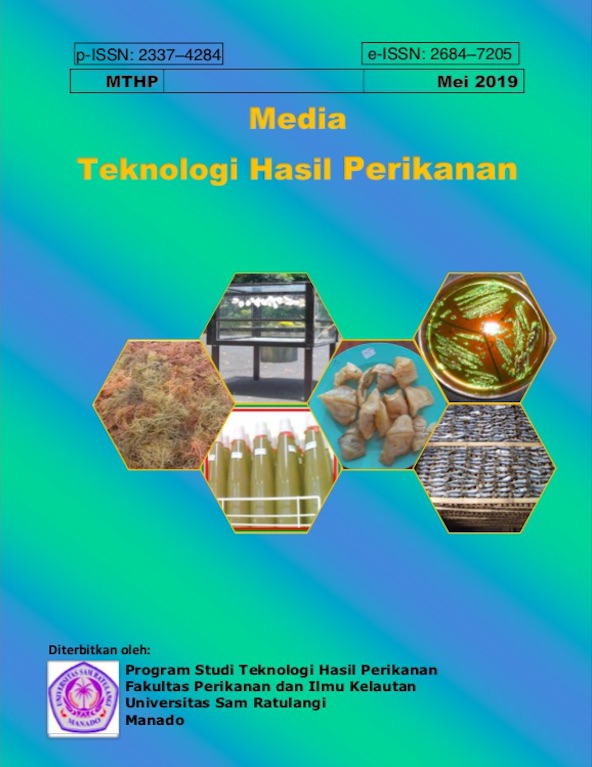ISOTERMI SORPSI AIR IKAN KAYU (Katsuo-Bushi) YANG DIBUAT DENGAN KONSENTRASI ASAP CAIR DAN LAMA PERENDAMAN YANG BERBEDA
DOI:
https://doi.org/10.35800/mthp.7.2.2019.23614Keywords:
Isotherm sorpsi water (ISA) Katsuo-bushi, liquid smoke, ikan kayu, asap cairAbstract
Dried smoked skipjack or better known as Katsuobushi, are included in smoking processed products, which are carried out in several stages. The weight of Katsuobushiis about 20% of the weight of the raw material, with a moisture content of 15-19%, because they have a long process of smoking and drying. According to Berhimpon et al. (2014), the weakness of katsuobushiin the world today is the high content of Polycyclic Aromatic Hydrocarbon (PAH), which it exceeds a maximum of 10 ppb, which it is the standard given by Korean as an importer country. Although, Japan as a bigger importer country did not gave a standard yet, but nowadays consumer have more concern to health. In their research Berhimpon et al. (2016) has examined katsuobushi processed using liquid smoke which it contains PAH <0.25 ppb. In this study katsuobushiwere smoked using liquid smoke, with concentration 2, 4, 6, 8% and soaking time 30, 60, 90, 120 minutes. The parameters tested were water content (AOAC, 2005), pH (AOAC, 2005),and moisture sorption isotherm (MSI) (Berhimpon, 1990). The results showed that soaking time had an effect on the value of water content and pH of liquid smoked katsuobushi, and MSI analysis showed a type 1 sorption isothermic curve and the best equation model fitted the MSI curves was Henderson equation with MRD value  of 4.9.
Keyword:Â Isotherm sorpsi water (ISA) Katsuo-bushi, liquid smoke.
Â
Ikan kayu atau lebih dikenal dengan Katsuo-bushi termasuk dalam produk olahan pengasapan, yang dilakukan secara bertahap. Ikan kayu memiliki berat sekitar 20% dari berat bahan baku, dengan kadar air 15-17%, karena mengalami proses pengasapan/pengeringan yang lama. Berhimpon dkk.. (2014), mengatakan bahwa kelemahan ikan kayu yang ada di dunia dewasa ini adalah tingginya kandungan Polycyclic Aromatic Hydrocarbon(PAH) yang melebihi 10 ppb, yaitu standar yang diberikan oleh Korea sebagai negara pengimpor. Walaupun Jepang sebagai negara pengimpor terbesar belum membatasi kandungan PAH, tetapi konsumen dewasa ini sudah mempertimbangkan kesehatan. Pada penelitian selanjutnya Berhimpon et al. (2016) telah meneliti pembuatan ikan kayu dengan menggunakan asap cair dan memperoleh ikan kayu yang kandungan PAH <0,25 ppb.Penelitian ini menggunakan metode pengasapan menggunakan asap cair dengan perlakuan yang digunakan ialah konsentrasi asap cair 2, 4, 6, 8% dan lama perendaman 30, 60, 90, 120 menit. Parameter yang di diuji adalah kadar air (AOAC, 2005), pH (AOAC, 2005), analisa isotermi sorpsi air (Berhimpon, 1990). Hasil yang didapatkan menunjukan bahwa, lama perendaman memberikan pengaruh terhadap nilai kadar air dan pH dari ikan kayu asap cair dan untuk analisa ISA menunjukkan kurva isotermi sorpsi air tipe 1 dan model persamaan yang paling baik adalah persamaan Henderson dengan nilai MRD 4,915.Â
Kata kunci:Â isotermi sorpsi air (ISA), ikan kayu, asap cair.
Â
Downloads
Published
How to Cite
Issue
Section
License
Authors who publish with this journal agree to the following terms:
- Authors retain copyright and grant the journal right of first publication with the work simultaneously licensed under a Creative Commons Attribution License that allows others to share the work with an acknowledgement of the work's authorship and initial publication in this journal.
- Authors are able to enter into separate, additional contractual arrangements for the non-exclusive distribution of the journal's published version of the work (e.g., post it to an institutional repository or publish it in a book), with an acknowledgement of its initial publication in this journal.
- Authors are permitted and encouraged to post their work online (e.g., in institutional repositories or on their website) prior to and during the submission process, as it can lead to productive exchanges, as well as earlier and greater citation of published work (See The Effect of Open Access).







